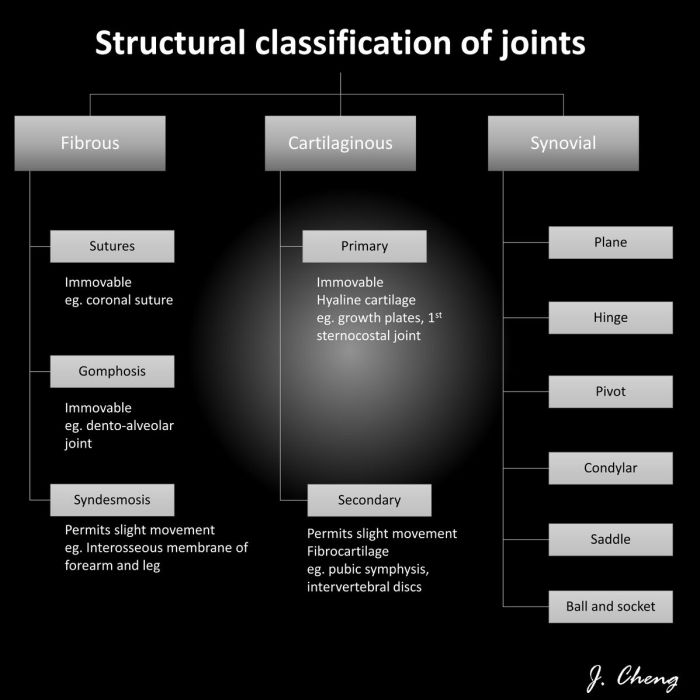The concept map: classification of joints embarks on an enlightening journey into the intricate world of human articulation, exploring the structural and functional diversity of joints that orchestrate our every movement. This comprehensive guide unveils the significance of joint classification in diagnosing and treating joint disorders, empowering healthcare professionals with a roadmap for effective patient care.
Delving into the structural basis of joint classification, we unravel the intricate interplay of connective tissue, joint cavity, and bone shape, which lay the foundation for categorizing joints. Functional classification unveils the spectrum of joint mobility, ranging from immovable to freely movable, providing insights into the mechanics of human motion.
Joint mobility, influenced by factors such as joint shape, ligaments, and muscles, further refines our understanding of joint function.
Classification of Joints: Definition and Significance

Joints are the points of contact between two or more bones in the skeletal system. They allow for movement, provide support, and facilitate the transmission of forces throughout the body. Joint classification is the systematic organization of joints based on their structural and functional characteristics.
It serves as a valuable tool for understanding joint mechanics, diagnosing joint disorders, and guiding treatment strategies.
Factors Considered in Joint Classification
- Type of connective tissue
- Presence or absence of a joint cavity
- Shape of the articulating bone surfaces
Structural Basis of Joint Classification
Types of Connective Tissue in Joints
- Fibrous tissue (e.g., ligaments, tendons)
- Cartilaginous tissue (e.g., hyaline cartilage, fibrocartilage)
- Synovial fluid
Presence or Absence of a Joint Cavity
- Synovial joints (with a joint cavity filled with synovial fluid)
- Non-synovial joints (without a joint cavity)
Shape of the Articulating Bone Surfaces
- Plane
- Hinge
- Pivot
- Condyloid
- Saddle
- Ball-and-socket
Functional Classification of Joints
Range of Motion, Concept map: classification of joints
- Synarthrosis (immovable joints)
- Amphiarthrosis (slightly movable joints)
- Diarthrosis (freely movable joints)
Types of Diarthrosis Based on Movement
- Uniaxial (e.g., hinge, pivot)
- Biaxial (e.g., condyloid, saddle)
- Multiaxial (e.g., ball-and-socket)
Joint Mobility and its Impact on Classification

Factors Affecting Joint Mobility
- Joint shape
- Ligaments
- Muscles
Types of Joint Mobility
- Hypermobile joints (excessive range of motion)
- Hypomobile joints (restricted range of motion)
Clinical Relevance of Joint Classification

Diagnosis of Joint Disorders
- Identifying joint injuries (e.g., sprains, dislocations)
- Diagnosing degenerative conditions (e.g., osteoarthritis, rheumatoid arthritis)
- Assessing mobility limitations (e.g., joint stiffness, contractures)
Treatment Strategies and Rehabilitation Plans
- Selecting appropriate treatment modalities (e.g., surgery, physical therapy, medication)
- Developing personalized rehabilitation programs to restore joint function and mobility
- Guiding decisions on joint replacement or other surgical interventions
Case Studies and Examples: Concept Map: Classification Of Joints

Case Study 1: Diagnosis of a Knee Injury
A 25-year-old male athlete presents with a painful, swollen knee following a sports injury. Examination reveals instability and a positive anterior drawer test, suggesting a torn anterior cruciate ligament (ACL). The ACL is part of a synovial hinge joint, which allows for flexion and extension but limits rotation.
Understanding the structural and functional classification of the knee joint helps the physician accurately diagnose the ACL injury and develop an appropriate treatment plan.
Case Study 2: Treatment of Osteoarthritis in the Hip
A 60-year-old woman presents with chronic hip pain and stiffness. X-rays show narrowing of the joint space and osteophyte formation, indicating osteoarthritis. The hip joint is a synovial ball-and-socket joint that allows for a wide range of motion. The diagnosis and treatment of osteoarthritis in the hip are guided by an understanding of the joint’s structural and functional characteristics.
Treatment options may include pain management, physical therapy, and, in severe cases, hip replacement surgery.
Essential FAQs
What is the significance of joint classification?
Joint classification provides a systematic framework for understanding the diverse range of joints in the human body, enabling healthcare professionals to accurately diagnose and treat joint disorders.
How does joint mobility influence classification?
Joint mobility, determined by factors such as joint shape and surrounding tissues, plays a crucial role in classifying joints based on their range of motion, from immovable to freely movable.
What is the clinical relevance of joint classification?
Joint classification serves as a valuable tool in clinical practice, guiding diagnosis, treatment planning, and rehabilitation strategies for a wide range of joint disorders.